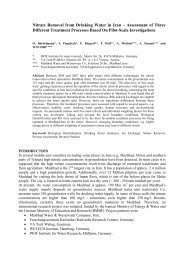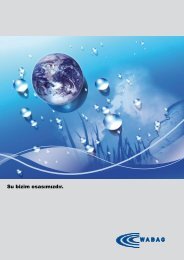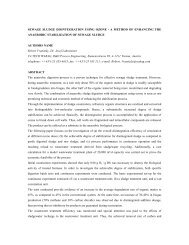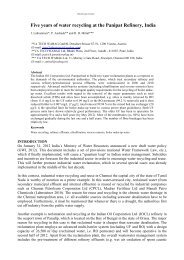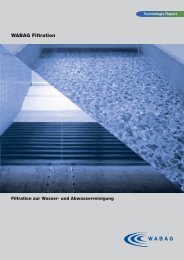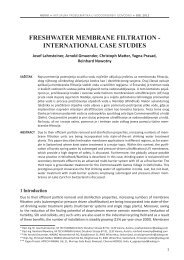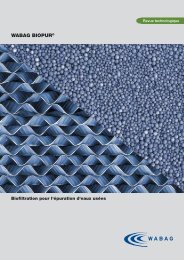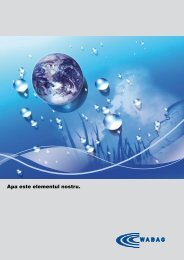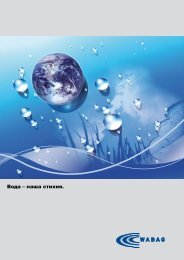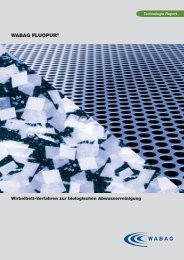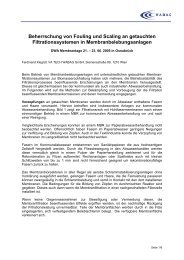Technology Review - Wabag
Technology Review - Wabag
Technology Review - Wabag
Create successful ePaper yourself
Turn your PDF publications into a flip-book with our unique Google optimized e-Paper software.
WABAG filtration<br />
Filtration for water and wastewater treatment<br />
<strong>Technology</strong> <strong>Review</strong>
WABAG filtration<br />
Water filtration<br />
for drinking and process water<br />
Filtration is an essential process in water treatment. It is<br />
frequently the case that it either represents the main processing<br />
phase, or is integrated into multi-barrier systems. Many<br />
membrane filtration plants also include conventional filters for<br />
pre- or post-treatment.<br />
Thus, the continuous development of filtration technology has<br />
always been one of WABAG‘s most important objectives and<br />
for more than fifty years, the techniques originally developed by<br />
Sulzer have been subjected to on-going optimisation.<br />
Today, WABAG‘s filter design constitutes an optimum solution<br />
for both, single- and multi-layer filters based on various unique<br />
features.<br />
Kunming, China<br />
Drainage Filtration for treatment of surface water<br />
Commissioning 2003, capacity 400‘000 m 3 /d<br />
Berne WWTP, Switzerland<br />
Nozzle Floor Filtration for tertiary treatment<br />
Commissioning 1984, capacity 14‘400 m 3 /h<br />
2<br />
Wastewater filtration<br />
for tertiary treatment and water reuse<br />
Wastewater filtration is necessary when discharge limits are<br />
particularly stringent, e.g. in sensitive areas. In addition, wastewater<br />
filtration in combination with disinfection also offers a<br />
reliable and economic solution for water reuse.<br />
WABAG‘s wastewater filtration technology derives from its<br />
experience with water filtration, which has been acquired since<br />
the late 1970‘s. It incorporates all the necessary know-how<br />
about the particular factors related to wastewater filtration such<br />
as the biological activity in the filter bed and control of filter<br />
operation with flow variations.<br />
Like water filters, wastewater filters are realised as single- and<br />
multilayer filters and offer the same features.<br />
TaiPo, Hongkong<br />
Aerated Drainage Filtration for nitrification and<br />
multilayer Drainage Filtration for mangenese removal<br />
Commissioning 2002, capacity 450‘000 m 3 /d<br />
Fällanden WWTP, Switzerland<br />
Nozzle Floor Filtration for tertiary treatment<br />
Commissioning 2003, capacity 1‘800 m 3 /h<br />
WABAG filtration<br />
rehabilitation<br />
The available filter floor systems offer optimised solutions for<br />
filter rehabilitation. The upgrading of pure water rinsing into<br />
air-water backwashing is entirely feasible. Extensive experience<br />
in filter rehabilitation also allows the optimisation of conventional<br />
backwash principles based on continuous flow and sludge<br />
water withdrawal channels.<br />
Daugava Riga, Latvia<br />
GAC Nozzle Floor Filtration for surface water treatment<br />
Commissioning 2001, capacity 240‘000 m 3 /d<br />
5<br />
WABAG filtration<br />
advantages in brief<br />
n Outlet regulated (constant water level) deep bed<br />
filtration results in high filtration performance<br />
n Efficient backwashing without filter media loss<br />
n Low backwash water consumption<br />
n Various filter floor systems enable tailor-made solutions<br />
and a wide range of filter media combinations<br />
n Compact design<br />
n Flexible realisation due to a wide range of filter surface<br />
areas (10-150 m 2 )<br />
Romanshorn WWTP, Switzerland<br />
Drainage-Nozzle Floor Filtration for tertiary treatment<br />
Commissioning 2007, capacity 1‘080 m 3 /h
Filtration process<br />
Filter features<br />
for most efficient backwashing<br />
General<br />
The filtration process is based on a downflow operation mode and filtrate outlet regulation. This maintains a constant water level in<br />
the filter, which offers the best process conditions for high elimination rates.<br />
Deep bed filtration with long filter running times is achieved by the selection of the optimum filter media in a single- or multilayer<br />
configuration.The filters can take the form of rectangular concrete cells (open or closed) or steel vessels.<br />
Filter floor<br />
The filter floor is a key system component. The design has to ensure the uniform distribution of the corresponding media during<br />
operation and backwashing, while the construction should be simple, cost-efficient and flexible enough to accommodate various<br />
filter dimensions.<br />
WABAG has developed differing types of filter floors, which allow a design in accordance with specific requirements, which is particularly<br />
important when existing filters are refurbished. The types of filter floors available are either based on the WABAG nozzle floor<br />
or the WABAG drainage system.<br />
WABAG drainage system<br />
The drainage system consists of cast-in distribution batteries and parallel drainage pipes, which are arranged across the filter bottom.<br />
The drainage pipes are surrounded by a supportive gravel layer. The appropriate orifices in the individual drainage pipes allow filtrate to<br />
pass out of the filter material and scouring air and water to move in the opposite direction. The drainage pipes are individually connected<br />
with the filtrate channel by means of distribution pipes. The gravel layer, drainage pipes and distribution batteries ensure the<br />
even distribution of the flushing media.<br />
An alternative drainage design consists of drainage pipes equipped with nozzles instead of orifices. In this case, the drainage pipes are<br />
also cast-in and there is no supporting layer of gravel needed.<br />
Backwashing<br />
Effective backwashing is vital for the optimised long-term operation of filters. The uniform distribution of the backwash media and efficient<br />
backwash sequences are therefore essential elements in backwashing.<br />
As far as operational costs are concerned, backwash water consumption should be as low as possible and filter media loss has to be<br />
avoided.<br />
These objectives are achieved by WABAG filter floor systems and a sophisticated backwash principle (excess head backwash, see<br />
below) using an internal flap valve for sludge water withdrawal. The flap valve is either situated on the front or the rear side of the filter<br />
cell, just above the top level of the filter medium.<br />
The excess head backwash principle divides the backwash sequence into a first phase of backwash medium introduction and a<br />
second phase of sludge water withdrawal. Backwash medium introduction can therefore be precisely matched to individual operational<br />
conditions.<br />
WABAG nozzle floor system<br />
This system is based on a concrete nozzle floor with a plenum chamber. The latter is fed from the front via a special backwash connection.<br />
The nozzle floor can easily be built using shuttering elements.<br />
Filter material<br />
Sludge water extraction is based on the gradual opening of the flap valve, which prevents filter media<br />
loss, even where this is highly possible as in the case of specifically light media. This allows an additional<br />
degree of flexibility with regard to filter media combinations.<br />
The repetition of the two phases leads to an efficient backwash with low backwash water use.<br />
Scouring air<br />
Backwash<br />
Raw water<br />
Orifice for scouring air<br />
Supporting layer<br />
Drainage pipe<br />
Filter bottom<br />
3 4<br />
Filtrate<br />
Backwash<br />
water outlet<br />
Excess head<br />
Washout flap valve<br />
Filter media<br />
Nozzle floor<br />
Filter underdrain<br />
Air distribuntion pipe<br />
Scouring air<br />
Water distribution pipe<br />
Backwash water<br />
Schematic diagram of the flap valve
WABAG is an international supplier of systems for:<br />
n Drinking water treatment<br />
n Industrial and process water treatment<br />
n Water reclamation<br />
n Sea and brackish water desalination<br />
n Municipal wastewater treatment<br />
n Industrial wastewater treatment<br />
n Sludge treatment<br />
WABAG is one of the world’s most innovative water<br />
treatment companies with know-how in specific techno-<br />
logies and in-house developed processes such as:<br />
n Fluidised bed biology FLUOPUR ®<br />
n Biofiltration BIOPUR ®<br />
n Activated sludge Hybrid, SBR<br />
processes<br />
n Anaerobic biological EKJ TM , UASB, an-OPUR TM ,<br />
processes EGSB<br />
n Membrane bioreactor MARAPUR ® , Megamodul TM<br />
n Membrane filtration RO, MF, UF, NF<br />
n Denitrification BIODEN ® , ENR ®<br />
n Oxidation processes ADOX ® , BIOZONE ®<br />
n Thermal desalination MED, TVC, MVC, MSF<br />
n Sludge digestion and BIOZONE ® -AD<br />
disintegration<br />
The WABAG Group represents a leading multinational<br />
player with companies and offices in 18 countries and<br />
a focus on emerging markets in Europe, North Africa,<br />
Middle East, South East Asia, China and India.<br />
VA TECH WABAG GmbH<br />
Dresdnerstraße 87-91<br />
1200 Vienna,<br />
Austria<br />
Tel.: +43 1 251 05 0<br />
contact@wabag.com<br />
www.wabag.com<br />
VA TECH WABAG Ltd.<br />
11, Murrays Gate Road<br />
Alwarpet , Chennai 600 018,<br />
India<br />
Tel. +91 44 422 323 23<br />
wabag@bdwt.com<br />
Maintenance &<br />
After Sales Services<br />
Operations<br />
(DBO, BOT, BOOT)<br />
Commissioning<br />
WABAG Water <strong>Technology</strong> Ltd.<br />
Bürglistrasse 31,<br />
CH-8401 Winterthur,<br />
Switzerland<br />
Tel. +41 52 262 43 43<br />
water@wabag.net<br />
Construction<br />
Consulting<br />
Equipment<br />
Supply<br />
Planning<br />
Design &<br />
Engineering<br />
sustainable solutions. for a better life.



